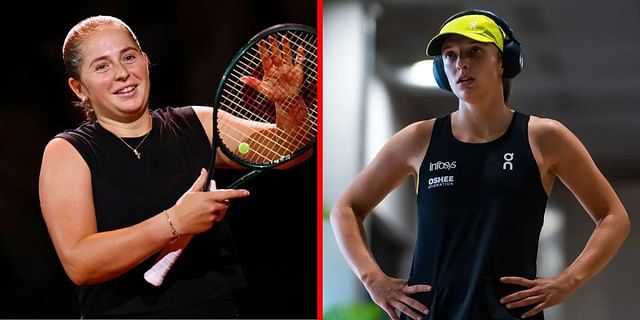Jelena Ostapenko pulled off yet another stunning performance to maintain her perfect record against World No. 2 Iga Swiatek, defeating the Polish star in the quarterfinals of the 2025 Porsche Tennis Grand Prix. The Latvian now boasts an unblemished 6-0 head-to-head record against Swiatek, continuing a streak that has perplexed fans and analysts alike.
Their clash on April 19 was highly anticipated, not just because of their history but due to the surface it was played on. For the first time, Ostapenko and Swiatek faced each other on clay – a surface on which Swiatek has shown immense prowess and consistency. The Pole, who has been widely regarded as one of the best clay-court players of her generation, was expected to pose a significant challenge to Ostapenko’s dominance, especially given her past success at the Stuttgart event.
Yet despite the surface favoring Swiatek, it was Ostapenko who came out swinging from the opening game. Determined to keep her streak alive, the Latvian adopted an aggressive strategy, taking charge of rallies early and pressuring Swiatek with deep, flat groundstrokes. Her relentless offense paid dividends, as she broke Swiatek’s serve three times in the opening set to take it 6-3.
While the opening set tilted heavily in Ostapenko’s favor, Swiatek wasn’t ready to surrender. In the second set, she showed why she is considered a clay-court queen, making tactical adjustments and showcasing her trademark movement and consistency. Swiatek managed to break Ostapenko’s rhythm, finding angles and using her heavy topspin to force errors. She claimed the second set 6-3, setting up a high-stakes decider.
But Ostapenko, undeterred by the shift in momentum, reasserted herself in the third set. After just over two hours of high-octane tennis, she sealed a 6-3, 3-6, 6-2 victory to once again deny Swiatek. The win not only solidified her flawless record against the current World No. 2 but also highlighted her versatility, as she has now beaten Swiatek on every surface — hard, grass, and clay.
The nature of Ostapenko’s 6-0 record against Swiatek is particularly intriguing given the contrast in their careers. Swiatek, a four-time Grand Slam champion and former World No. 1, has been dominant across the WTA Tour, especially on clay. In contrast, Ostapenko, though a Grand Slam champion herself with a 2017 French Open title, has struggled with consistency over the years. Yet, she seems to elevate her game every time she faces Swiatek.

Ostapenko was asked after the match whether she enjoys playing against Swiatek or if perhaps it’s a case of Swiatek struggling with Ostapenko’s style. The Latvian, currently ranked World No. 24, offered a light-hearted response, saying, “Maybe it’s both. I just try to play my game against her, stay aggressive, and not let her dictate.”
There’s a tactical explanation behind this dominance. Ostapenko’s flat and powerful shots often neutralize Swiatek’s topspin-heavy game, especially when Ostapenko maintains consistency and controls the pace. Her ability to hit winners from both wings and take the ball early has consistently disrupted Swiatek’s rhythm.
This win marked Ostapenko’s second triumph over Swiatek in 2025 alone. The two last met just weeks earlier at the Qatar Open semifinals, where Ostapenko dismantled the Pole in straight sets, 6-3, 6-1. That victory in Doha was arguably one of the most lopsided in their rivalry, highlighting the Latvian’s increasing confidence.
Their rivalry reignited in 2023 during the US Open, where Ostapenko pulled off a dramatic fourth-round upset over Swiatek. After dropping the first set, she stormed back to win 3-6, 6-3, 6-1, ending Swiatek’s title defense at Flushing Meadows.
Back in 2022, they faced off in the round of 16 at the Dubai Tennis Championships, a match that turned into a thriller. After dropping the first set, Ostapenko recovered in stunning fashion to take the match 4-6, 6-1, 7-6(4), saving match points in the process.
Their earlier meetings further demonstrate Ostapenko’s unique dominance. In 2021, during the round of 16 at Indian Wells, she outplayed Swiatek 6-4, 6-3 with another assertive performance. But perhaps the most surprising result came in their very first encounter back in 2019 at the Birmingham Classic. In that match, Ostapenko destroyed the then-up-and-coming Swiatek 6-0, 6-2 in just 65 minutes.
The ongoing rivalry between Ostapenko and Swiatek is as fascinating as it is unexpected. While Swiatek’s success has been built on a foundation of consistency, stamina, and strategic precision, Ostapenko brings raw power, shot-making flair, and an all-or-nothing attitude to the court. Against most players, Swiatek’s relentless pace and control prove too much to handle. Against Ostapenko, however, her patterns often fall apart due to the Latvian’s explosive baseline game.
It’s rare in tennis to see one top player have such a lopsided head-to-head against another elite competitor, especially when the latter is generally more successful overall. Yet Ostapenko seems to have cracked the code against Swiatek — she plays freely, almost fearlessly, against the Polish star, attacking from every corner of the court.
What’s particularly notable is that Ostapenko hasn’t just squeaked out wins — several of her victories have been dominant. Whether it’s a straight-sets cruise or a hard-fought battle, she has repeatedly found ways to come out on top.
With her quarterfinal win over Swiatek, Ostapenko now advances to the semifinals in Stuttgart, where she will face another formidable opponent: Ekaterina Alexandrova. This matchup is bound to deliver more fireworks as the two players share a long-standing rivalry of their own. The Stuttgart clash will mark the 11th meeting between them, and fittingly, the head-to-head record stands evenly at 5-5.
Their encounters have often featured big hitting and momentum swings, as both players prefer to play aggressive baseline tennis. While Ostapenko will enter the semifinal with a psychological edge after her latest win, Alexandrova has had her fair share of wins against the Latvian as well, making it an unpredictable contest.
With a spot in the final on the line and a potential chance at claiming the prestigious Stuttgart title, both players will be looking to bring their A-game.
For Swiatek, the loss is a surprising setback in what is usually her strongest part of the season. The Pole has made a name for herself on clay, winning multiple Roland Garros titles and routinely dominating the field during the spring months. Her early exit in Stuttgart, especially at the hands of Ostapenko, raises questions about her current form and perhaps the psychological hurdle she faces when playing the Latvian.
While a 6-0 record against a single player might not define a season, it could weigh heavily on Swiatek’s mind should they meet again in future tournaments, particularly with Roland Garros just around the corner. Her team will likely study this loss closely, looking for ways to break the pattern and reclaim dominance over Ostapenko.
As for Ostapenko, this victory is another chapter in her resurgence. After years of inconsistency and fluctuating rankings, she’s started 2025 with a renewed sense of purpose. Already having notched two wins over Swiatek this year alone, Ostapenko appears poised to re-establish herself among the game’s elite.
Her journey has been one of highs and lows, but when she’s at her best — like she was against Swiatek in Stuttgart — she can challenge and defeat anyone in the world. If she maintains this level, the Latvian could become a serious threat during the clay season and beyond.
With the Stuttgart semifinals on the horizon and confidence running high, Jelena Ostapenko may just be entering one of the most exciting phases of her career. And for Iga Swiatek, the Ostapenko conundrum remains an unsolved puzzle — one that she’ll be eager to crack as the season progress.








